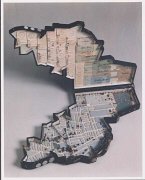|
|

|

|
Leon Jakubowicz and his wife Rachela holding the model of the Lodz ghetto that Leon created. The model recreates, on a small scale, the physical appearance of the ghetto, creating the shape of the model to mimic the exact boundaries, streets, ... See more photographs |
FEATURED ARTIFACT: MODEL OF THE LODZ GHETTO |
||
|
|
The city of Lodz is located about 75 miles southwest of Warsaw, Poland. The Jews of Lodz formed the second largest Jewish community in prewar Poland, after Warsaw. On the eve of the war there were 223,000 Jews in Lodz out of a population of 665,000. German troops occupied Lodz one week after Germany invaded Poland on September 1, 1939. Lodz was annexed to Germany as part of the Warthegau. The Germans renamed the city Litzmannstadt, after a German general, Karl Litzmann, who had captured the city during World War I. In early February 1940, the Germans established a ghetto in the northeastern section of Lodz. About 160,000 Jews, more than a third of the city's population, were forced into a small area. |
Leon Jakubowicz, a shoemaker by training and a native of Lodz, began constructing this model of the Lodz ghetto in the spring of 1940, after the ghetto was sealed. Jakubowicz's model recreates, on a small scale, the physical appearance of the ghetto, creating the shape of the model to mimic the exact boundaries, streets, and buildings that had a major impact on daily life in the ghetto. The model includes official badges and seals of institutions run by the ghetto's Jewish organization, including schools, hospitals, civic offices, factories or "ressorts" functioning inside the ghetto, as well as printed money used in the ghetto but virtually worthless in value. Click on the thumbnail and use the zoom tool to examine this artifact. |
 |
||
|
See more artifacts Model of the Lodz ghetto |
|
In the spring of 1944, with the ghetto population still numbering some 75,000 Jews, the Nazis began to liquidate the Lodz ghetto with deportations first to the Chelmno killing center and ultimately, by August, to Auschwitz-Birkenau. |
|
Jakubowicz continued to develop the model until he and his wife, Rachela Zylber, were deported from the ghetto in August 1944, when all remaining inhabitants of the ghetto were deported to Auschwitz. Rachela is presumed to have perished in Birkenau. Just before he was deported, Jakubowicz was able to bury the model in the basement of his building. In his own words: "I took the model which is 15'' by 34'' and wrapped it in tar paper, and buried it in a metal trunk in the basement of my building. The building on Brzezinska ... was eventually destroyed." Jakubowicz was transferred to forced-labor camps in Germany. He was liberated by U.S. troops in early May 1945. Leon discovered that his brothers had also survived. He told them where in Lodz he had buried the model. They were able to find it in the rubble of the destroyed building. Leon's brothers dug out the model and took it to him in Germany. Although Leon and his two brothers survived, they lost their immediate and extended families in the Holocaust. After the war, Leon found out that his mother had died in Auschwitz. His father had died in the Lodz ghetto. Leon himself emigrated to Israel. He lived there until 1958 when he came to the United States, bringing the model with him. Leon loaned this artifact to the United States Holocaust Memorial Museum in 1990. The model was donated to the Museum in 1996. |
|
|